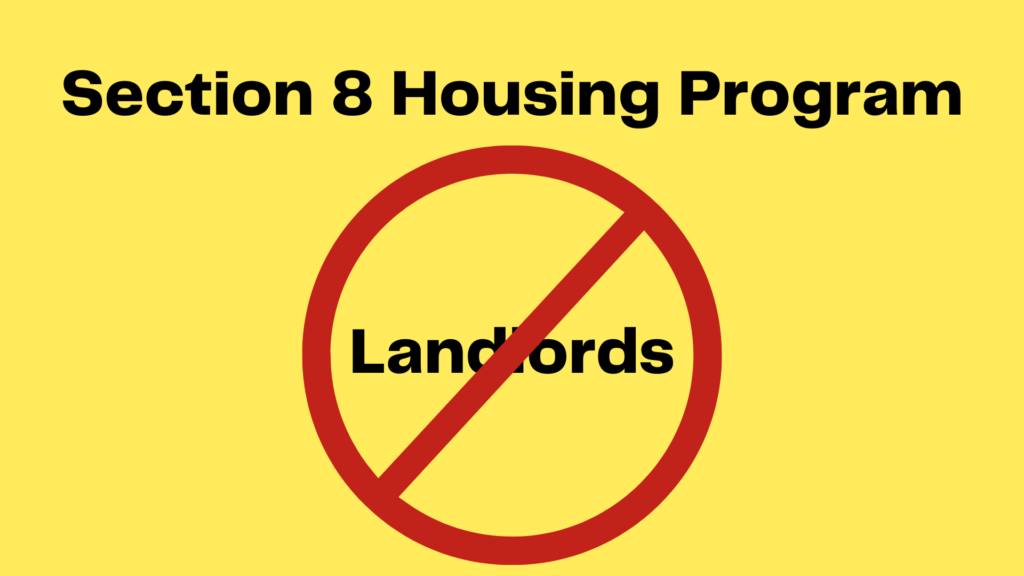Being a Section 8 real estate investor will generally reduce tenant turnover and nearly guarantee that the rent gets paid. However, the benefits of the program stop right there.
I have owned rental properties for over 15 years. I currently have more than 70 rental houses and own a property management company. I have rented to many Section 8 tenants and dealt with the housing authority for over a decade. Using my personal experience, I’ll tell you the 13 most aggravating aspects of being a Section 8 landlord.
What is the Section 8 Program?
The Section 8 Housing Choice Voucher (HCV) program is a federal government program that provides rental assistance to low-income families. The amount of aid is based on family size, income, and local market conditions. Each participant will receive a housing voucher that can be used to pay all or a portion of the rent.
The housing program participants use the housing voucher to search for a property in the private housing market. Once a suitable property is found, the voucher is used to pay a portion of the monthly rent directly to the landlord. If the rent exceeds the voucher, the tenant is responsible for covering the shortage.
Goals of the Section 8 Program
Provide affordable housing to low-income families.
The Section 8 program helps low-income families pay their rent so that they can afford to live in decent, safe, and sanitary housing.
Increase housing choices for low-income families.
The Section 8 program allows low-income families to choose where to live rather than being limited to public housing projects.
Promote economic self-sufficiency.
The Section 8 program can help low-income families save money and build assets, leading to economic self-sufficiency.
Improve the quality of life for low-income families.
The Section 8 program can help low-income families live in safer and healthier neighborhoods, improving their quality of life.
Who Manages the Program
The Section 8 program is managed locally by public housing agencies (PHAs). The local PHA receives federal funds from the U.S. Department of Housing and Urban Development (HUD) to administer the voucher program. For more information on the Section 8 program, check out the HUD reference for the housing choice voucher program.
The HAP Contract
A HAP or Housing Assistance Payments contract is a written agreement between the local public housing agency and a landlord. The HAP contract outlines the terms and conditions of the Section 8 program.
Under the HAP contract, the housing authority agrees to pay the landlord a monthly subsidy on behalf of a participating family. The tenant is responsible for paying the remaining rent, utilities, and other expenses.
The HAP contract is typically for one year and must be renewed each year. The housing authority can terminate the contract if the landlord fails to meet the program’s requirements, such as maintaining the property in good condition or providing safe and sanitary housing.
1. Not Landlord Focused

The Section 8 program exists to serve families in need and, as a result, is not landlord-focused. Each Section 8 participant has a case worker, who often does not directly deal with the landlord.
For working with landlords, the public housing agency uses a landlord liaison. Landlord liaisons provide landlords with information about the Section 8 program, including how to become a participating landlord, screen tenants, and collect rent. They also help landlords resolve any problems they may have with the program.
Under this housing voucher program, many property managers share the same landlord liaison. Consequently, the liaison is often overworked and unable to respond to property owners in a timely manner. This alone is the biggest problem with being a Section 8 real estate investor.
2. Government Bureaucracy

The Section 8 voucher program is the apex of government bureaucracy. Like most government programs, it is administered by a complex system of rules and regulations that can sometimes make it difficult for people to access the necessary benefits.
As a landlord, you will find that payments are often late, and some inspection requests can be unreasonable. When there are problems, it can be challenging to contact the owner liaison or anyone that can make a decision.
3. Increased Time to Fill Vacancies

The process for a tenant to move can be tedious and time-consuming. The program participant and the landlord must complete the proper paperwork and wait for the overworked case worker to process it. Sometimes, the paperwork can’t be processed fast enough, and the deadline is missed.
When the lease end date is reached, the rent payment from Section 8 will stop, but the house may not be vacant. In addition, there are other scenarios in which Section 8 will stop paying rent, but the tenant will still be in the house.
To make matters worse, section 8 voucher holders who overstay their exit date are often responsible for the additional rent. The landlord may be unable to collect this rent from the Section 8 program, and the tenant can rarely afford to pay; that’s why they are in the program.
Once the tenant has left the house, the Section 8 real estate investor has the expensive task of getting the house ready for the next tenant. Once a suitable renter is found, the Section 8 approval process will begin. This step will last weeks to months while the house sits vacant, running up utility bills and being at risk of vandalism. Long after you could have rented to a regular tenant, the section 8 tenant moves in.
4. Difficult to Remove Problem Tenants

Getting rid of problem section 8 tenants can be more challenging than evicting tenants who are not part of the program due to specific regulations and requirements that landlords must follow. To evict a tenant, the landlord has to follow the same procedures as any other tenant, such as providing notice and filing for eviction in court. However, landlords must also comply with additional regulations related to the Section 8 program, such as notifying the local housing authority.
It’s important to understand that the Section 8 program does not always pay 100% of the rent. The voucher will state the maximum rent you can charge and the amount the housing choice voucher program will pay. The voucher holder is responsible for covering the rent between the voucher amount and the amount charged (and allowed by the voucher). If the tenant doesn’t pay their portion, your options are limited. It’s challenging to evict a Section 8 tenant, and do you even want to if the tenant owed portion is small?
5. Harder to Get Market Rent
The Section 8 program limits the rent that can be charged for a unit based on the area’s fair market rent (FMR). The FMR is calculated based on the local rental market and can vary depending on the area. In some cases, the calculated FMR may be lower than the actual market rent that a landlord could charge, leaving them with two options: take reduced rents or turn down a Section 8 tenant.
Don’t let the term fair market rent confuse you. This rent limit is calculated using a formula and is often anything but the fair market value. Formulas get outdated, and local trends change quickly. Even worse, FMR might be acceptable when you initially rent, but they hold back your ability to raise rents to the market rate as years pass.
Ensure you know the fair market rent before the housing authority tells you. It can save a lot of frustration and help you recognize when their number is wrong. If you are starting out as a Section 8 real estate investor and need help, read my article on determining fair market rent.
6. Problems with Rent Increases

Raising the rent for a Section 8 tenant can be a headache, even when the tenant is okay with the increase. The housing authority frequently has arbitrary deadlines, many months in advance, after which you cannot submit a rent increase. In addition, the rate increase request may be met with, “We are not increasing rental amounts at this time.”
I have experienced problems raising the rent on more than one occasion. I had a great tenant for almost ten years, and the rent increase was denied each year. Eventually, the tenant pleaded with the case worker to allow a rent increase to no avail. Ultimately, I had to ask the tenant to leave when the lease expired. It’s been five months, and my new tenant is at market rent which is 25% higher.
7. Security Deposit Troubles
HUD does not pay security deposits; the tenant must come up with this payment themselves. Frequently, the tenant will not have the full deposit but must move in or lose the housing voucher. This is often after you have waited a long time for the housing authority to process the rental request. After waiting so long, it’s tempting to allow the tenant to move in any way a catch up on the security deposit.
When managing rental properties, it’s not uncommon to deduct from the security deposit security while the tenant is still in the unit. This usually covers damage caused by the tenant, which is not worth an eviction.
With a regular tenant, you can allow them to pay back the deposit over time or face eviction. This doesn’t work with a Section 8 tenant, who often has no extra income and is difficult to evict. When you stay with the partial security deposit, you usually need the difference when the tenant leaves.
8. Lower End Neighborhoods
You frequently have properties in bad neighborhoods when renting exclusively to section 8 tenants. This is not because of the Section 8 tenant but because of the cap put on the rental rates.
When rents are capped, real estate investors move to lower-end neighborhoods to find properties that will cash flow. As a result, the section 8 real estate investor will have a portfolio with a large percentage of homes in lower-end neighborhoods.
In addition to the fair market rent formula, the rent is subject to a dollar amount cap. The maximum rent paid will often not cover the fair market rent of a lovely home in a good neighborhood. As a result, landlord catering to section 8 tenants tend to provide houses in lower-tier areas.
9. Problematic Tenants

Lower-income tenants are higher-risk tenants. This is not because they are lower income; it’s because a low income is a common trait of the higher-risk tenant pool. On average, the higher-risk tenants will cause more damage to the property, resulting in more neighbor complaints, and are generally more challenging to deal with.
With problematic tenants come greater expenses. The Section 8 program, by statute, only allows the property owner to charge market rent or less. This prevents a landlord from increasing the rent to compensate for these unique challenges.
10. Background Checks are Pointless
In many cases, tenant screening and background checks are nearly useless. The potential renters on the Section 8 program must be low-income, which makes it difficult to pay their bills. Many of these prospective tenants have bad credit, so setting a minimum credit score requirement is useless.
While most low-income people are of outstanding character, criminals and other troublemakers also have trouble holding jobs and fall into the low-income category. This fills the pool of potential tenants with problem tenants, making it difficult for many Section 8 tenants to pass a traditional background check.
11. Worthless Inspections
The intent of Section 8 inspections is to ensure that a rental unit meets basic health and safety standards. The inspections are conducted by the housing authorities or other contracted inspectors and must be completed before a tenant can move into a Section 8 property.
Your house may often fail an inspection for a minor problem caused by the tenant, such as a rip in the linoleum. Everyone agrees it’s the tenant’s fault, but they can’t afford to fix it. If the landlord doesn’t repair at their cost, the housing authority will cut off the rent.
The inspectors do an excellent job of checking some items, such as that the heating and plumbing system works. However, they often find trivial issues that slow down the process.
After 15 years of renting to section 8 tenants, I’ve never seen an inspector wriggle through a crawlspace to check for structural issues. I have seen them fault me for the lack of screens on a window or because a pane glass window can’t open (these windows are not supposed to open).
12. Difficult to Sell the Property

In most cases, the sale of a property is subject to the existing lease agreement. If the lease is with a Section 8 tenant, your buyer pool is restricted to the landlord that will work with the Section 8 program. Only potential buyers who accept housing choice vouchers will be interested in your property.
Some housing authorities have onerous requirements for being a Section 8 landlord, such as taking a class. This further complicates your chances of finding a new landlord who will wait out the lease.
As mentioned previously, section 8 houses are often in lower-end neighborhoods. Homeowners who qualify for a mortgage tend to prefer nicer areas. This fact further reduces the pool of available buyers.
13. Rent Gets Reduced
The Section 8 rent amount is based on more than the supposed market rent. It is also based on the participant’s income and family makeup. If any of these properties changes, the tenant’s rent amount will be adjusted. However, when the voucher amount is adjusted upward, the fair-market-value rent acts as a cap preventing the rent from going up. If the voucher is adjusted downward, you must reduce the rent, or the tenant must leave.
Conclusion
As a section 8 real estate investor, you will face unique challenges. When dealing with Section 8 rents, there is always a third party in any discussion; the local housing authority. Interjecting a third party into the two-party relationship of tenant and landlord tends to make everything more complicated.
While conventional wisdom may say dealing with the section 8 tenants is the problematic aspect, I’m afraid I have to disagree. The hardest part of being a Section 8 property manager is dealing with the housing authority and its arcane rules. In this article, I have given the 13 biggest problems for landlords renting to section 8 tenants. Now that you know them, you can devise a plan to overcome them.
If you are starting out as a real estate investor, check out my ultimate guide for buying your first rental property.




